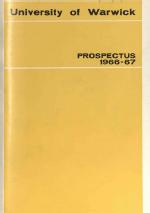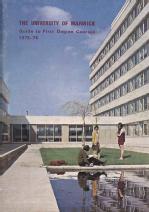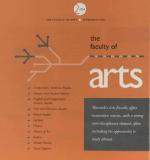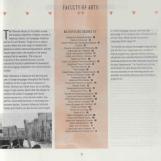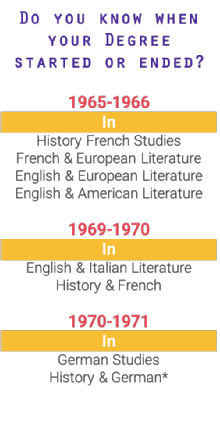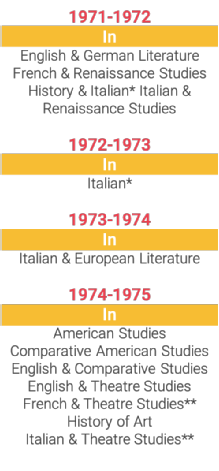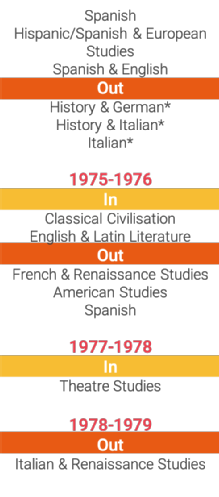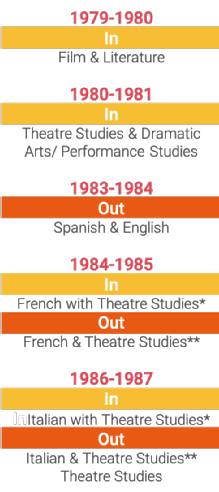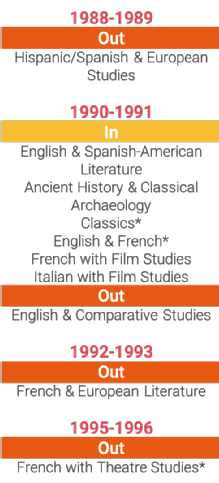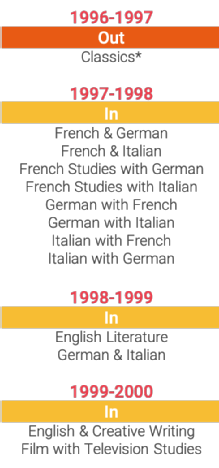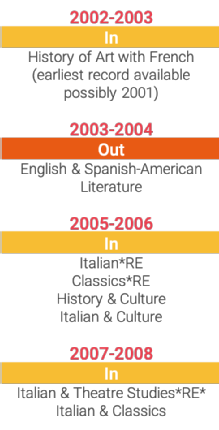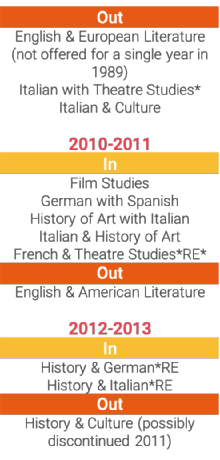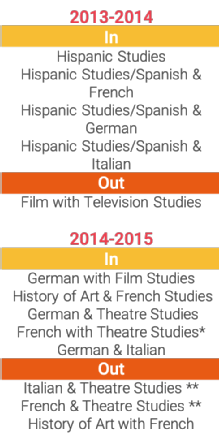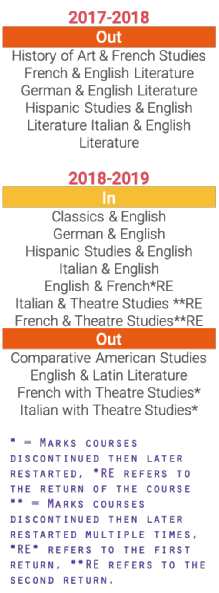Degree Timeline
ACADEMIC UNDERGRADUATE DEGREE COURSES IN THE FACULTY OF ARTS.
THEN & NOW 1965-2020
The Faculty of Arts was one of the founding faculties of the University of Warwick and is arguably one of the most diverse having offered over 150 different undergraduate degree courses, including joint degrees, over the duration of its existence. Undergraduate degree courses form the core of the University’s taught output therefore, these webpages look to provide a brief overview and exploration of the those offered by the Faculty of Arts.
In the university’s first academic year 1965/66, 32% of all undergraduate students enrolled were students of the Arts Faculty undertaking degrees in either History, French Studies, English & European Literature, French & European Literature, English & American Literature or History & Politics. From these few initial courses, the Faculty has expanded to be running over 100 undergraduate degree courses including joint degrees by 2018. The scatter graph (Figure 1) endeavours to quantify this growth by mapping the number of undergraduate degree courses offered each year to prospective students.
Figure 1: Scatter Graph of the Number of Undergraduate Degree Courses per Year Offered to Prospective Students.
The term “Independent Degrees” is intended to describe all single honour degrees and joint degrees for which each/a part was/is not available individually. Example: Ancient History & Classical Archaeology – neither subject component is available to study individually. Example of a course not deemed as “Independent”: French & German – since both subject components are available individually. Variations to this line would be a matter of opinion as to what defines “independent”. However, the plotted lines give a fair indication of the impact of joint degrees on the number of degree courses offered.
The statistical data was derived from available Prospectuses of the given year therefore, potentially still may include any courses that were subsequently revoked before commencing; however, the magnitude of any errors impact on progressive trends can be deemed as minimal.
Figure 1. displays the overall expansion of degree course options since the faculty began. The trend in “independent degrees” has slightly declined since 2006 however, the inclusion of joint degrees reflects the focusing of attention to delivering numerous combinations of subjects within degree programmes to tailor courses to meet the specific interests of students and increase diversity of learning.
There have been several factors that have affected the development and survival of courses:
Demand – New courses may be developed as a result of the expressed interest in a given subject.
Observed popularity of courses at other universities
Example: The practical art module within the History of Art degree was based on the success of Fine Arts at other institutes.
Popular optional modules
Examples: Italian, History of Art and Film Studies evolved from popular optional modules.
Italian was an optional module from 1965, but was not advertised in prospectuses as an independent degree until 1972. It was only briefly offered from 1972-74, but returned decisively in 2005.
The History of Art optional modules were first offered in 1970 and over 40 students participated in them, developing into an independent degree in 1974.
Gathered opinions of current students.
However, a lack of demand could result in a course being terminated.
Finance - Supportive funding needs to be securely in place for new courses to be put out. Sometimes there was demand for a specific degree course however, a lack of resource hindered its release.
Example: Film Studies
The Film Studies department developed the optional module An Introduction to Film Studies, which was first available in the academic year 1970/71, and proved to be popular being elected by 41 students. An independent degree in Film Studies was planned to be offered in 1977 however, due to financial strain felt by the University as a result of a decision to reduce Governmental financial support to Higher Education Institutes in July 1976, it was postponed. A fully independent Film Studies degree was not advertised to prospective undergraduate students until 2010.
Specialists available – the moving on and lack of specialists in an area may cause a decline of a course or the employment of a new expert could offer new potential directions to develop curriculums and courses.
The majority of fluctuations in degree course numbers shown in Figure 1 are moderate and the result of a few gains or losses for one of the reasons stated above. However, the definitive spike in joint degrees from 2015 requires clarification. This uncharacteristic sharp rise was largely caused by the mass roll out of joint degrees comprised of various differing permutations of modern languages introducing options of Arabic, Chinese, Japanese, Russian and Portuguese in combination with either French, German, Spanish or Italian and, from 2016, with any two of these languages. Figure 2 below maps the number of modern languages available per year both independently and in combination with other languages.
Figure 2: Line Graph Illustrating the Number of Modern Languages offered within Degree Courses to Prospective Students per Year.
The statistical data was derived from available Prospectuses and University of Warwick Annual Reports presented by the Vice Chancellor
The surge in 2015 in the number of languages available in combination with other languages provides supporting evidence that the spike in degree courses was caused by these languages in various permutations. French Studies introduced in 1965 and German Studies in 1970 have been the constant modern language courses. Italian and Spanish briefly featured during the 70s and early 80s independently or joined, but were firmly established in 2005 and 2012 respectively. This line graph solely represents languages in official undergraduate degrees offered by the university. However, it is important to note that the University has had consistently a buoyant and diverse linguistic culture fostered by the Language Laboratory and that many languages were available as optional modules. The Language Laboratory has offered a multitude of extra and evening courses in a diverse range of languages to various levels of competency and a number of optional modules all with high levels of participation as well as facilities for private, individual study. It was probably this high demand for language courses and options that inspired the development of more independent language degrees and languages combined with other subjects both within and beyond the Faculty of Arts.
Previously, Literature degrees appear to have been particularly dominant. The pie charts in Figures 3 and 4 illustrate the proportion of undergraduate degree courses that were composed of a specific subject, excluding languages, for 1975 and 2018 respectively.
Figure 3: Pie Chart representing the Proportion of Undergraduate Degree Courses including stated specific subjects, excluding Languages, in 1975.
Figure 4: Pie Chart representing the Proportion of Undergraduate Degree Courses including stated specific subjects, excluding Languages, in 2018. Statistical data was derived from available Prospectuses.
Figure 5: Pie Chart representing the distribution of Literature Students in 1975 across the Various Literature Degrees. Statistical data derived from the Annual Reviews presented by the Vice Chancellor
In 1975, with the exclusion of languages, 41% of offered undergraduate degree courses were literature based and approximately 39% of all Faculty of Arts students were enrolled in a literature degree. Literature degrees were also amongst the most popular applied for courses with English and American Literature being specifically mentioned for its high application rate in the 1967/68 Annual Review presented by the Vice Chancellor.
In 2018 there was arguably greater balance between the different subjects with the expansion of specific departments. For example, in 1975 Classical Civilisation was the only Classical Studies based degree offered to prospective students whilst in 2018 the additions of Classics, Ancient History and Classical Archaeology with the possibility of combinations with modern and ancient languages were possible.
CONTINUED RESEARCH…
The Covid-19 crisis has had impact upon the extent of this research. Due to travel bans and social distancing measures, research in archives at the Modern Records Centre, where most of the necessary archival material resides, has become prohibited. Progress is still continuing from content available on digital resources but not all archival content is digitally available or complete, slowing progression and efficiency. However, research would continue where possible into student’s numbers and participation with degrees as well as more in-depth research into the development of individual degree programmes, focusing on unique academic aspects of the University of Warwick’s Faculty of Arts.

